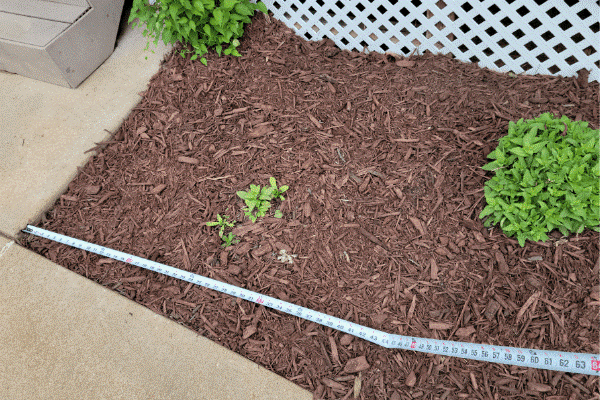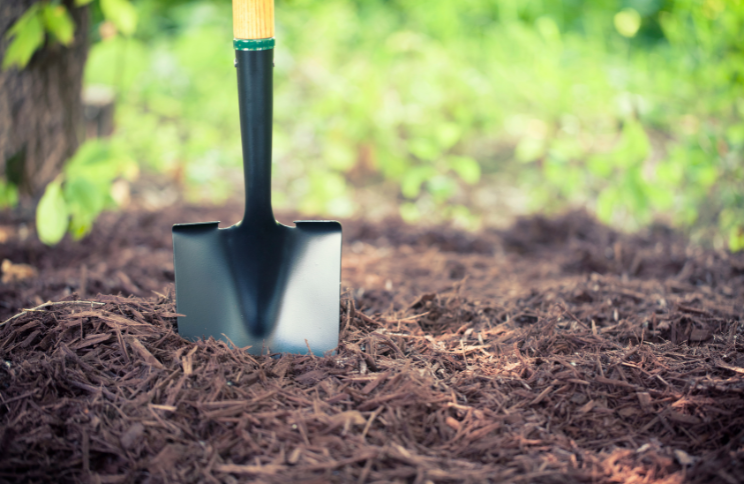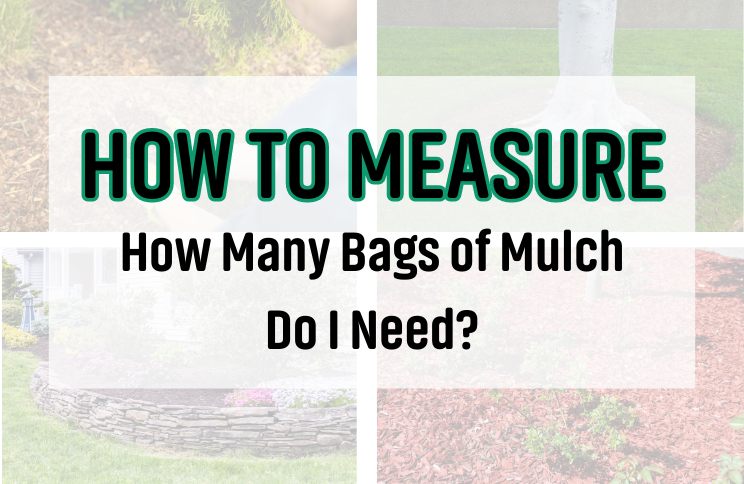Whether you’re a seasoned gardener or a beginner, one question is always nagging at the back of your mind: “How Much Mulch Do I Need?”. It can be daunting to figure out the exact amount of mulch you need to cover your garden beds, and it’s important to get the calculations right to save time and effort.
To calculate the mulch needed, use this formula: Mulch Volume (in cubic yards) = [(Length (ft) × Width (ft) × Depth (ft))/27]. Add 5-10% extra for miscalculations or unexpected requirements. For irregular shapes, break them down into regular rectangular or square ones to calculate.
Please read the rest of the article as we delve deeper into each step to figure out how we arrived at this formula and how you can use it to make your calculations simpler.
Importance of Proper Mulching
Mulch is an important part of gardening and provides the following benefits:
- Adding a layer of mulch enhances your space’s aesthetic appeal and improves your garden’s overall health.
- Mulch helps conserve moisture in the soil, reducing the need for frequent watering.
- It also suppresses weed growth, acting as a barrier that makes it difficult for weeds to access the sunlight they need to grow.
- Moreover, certain types of mulch, such as wood mulch or compost, can enrich the soil by adding organic matter as they decompose. This process improves soil structure, provides essential nutrients, and promotes the proliferation of beneficial soil organisms.
- Mulch also acts as an insulator, protecting plant roots from extreme temperature fluctuations.
Calculating Mulch Quantity
To calculate how much mulch you need, consider three primary factors: the total area you want to cover (square footage) and the desired depth of the mulch layer (in inches).
- First, measure the length and width of your landscape bed. Multiply these measurements (lxw) to get the total square footage. For instance, if your bed is 10 feet long and 4 feet wide, the total area is 40 square feet.
- Next, determine the desired depth of your mulch layer. Aiming for 2-3 inches depth is a general rule of thumb.
- Finally, it’s important to know that mulch is often sold in cubic yards. We’ll put these in a formula in later sections below.
Note that this calculation assumes a rectangular area.
Measuring the Area for Mulching

Measuring the area you intend to mulch is essential before you can calculate how much mulch you need. This is typically done in square feet (sq ft). To measure the area, you’ll need to determine the length and width of the space in feet.
This is a simple multiplication of length times width for rectangular or square beds. If your bed has an irregular shape, don’t worry; we will cover how to handle that in a later section.
Remember, accurate measurements are crucial to ensuring you purchase the right amount of mulch. An overestimation can result in wasted money and leftover mulch, while an underestimation may leave parts of your planting beds exposed, reducing the effectiveness of mulching.
Understanding Mulch Depth

A proper mulch layer should be about 2-4 inches deep, ideally 3 inches. Any less than this, and you may not effectively suppress weed growth or retain moisture. On the other hand, a layer thicker than this can suffocate plant roots and may lead to rotting.
The depth of mulch can also depend on the type of mulch material you’re using. For instance, finer mulches like compost or dyed mulch can be applied slightly thinner because they compact more. At the same time, larger materials like wood chips or pine bark nuggets may require a thicker layer to provide the same level of coverage.
When calculating how much mulch you need, you’ll need to convert this depth into feet (since our other measurements are also in feet). So, for a 3-inch layer of mulch, you’d use a depth of 0.25 feet in your calculations.
The next section will combine these measurements in our mulch calculation formula.
Mulch Calculation Formula
While the previous sections broke down the mulching calculation into a step-by-step process, let’s simplify that into a general formula for quicker reference:
- Convert all measurements to feet. (Length, width, and depth)
- Calculate the area in square feet (Length × Width)
- Calculate the volume in cubic feet (Area × Depth)
- Convert cubic feet to cubic yards (Cubic Feet ÷ 27)
Here’s the mulch calculation formula put together:
Mulch Volume (in cubic yards) = [(Length (ft) × Width (ft) × Depth (ft))/27]
Use this formula to calculate the volume of mulch you need. Always remember to use the same units for all your measurements. In this case, we’re using feet.
Example Calculation Using the Mulch Formula
Let’s walk through an example using our mulch calculation formula to clarify it.
Suppose you have a rectangular bed that measures 20 feet in length and about 4 feet in width. You aim to apply a mulch layer of 3 inches deep.
Follow these steps:
- Convert all measurements to feet. The length and width are already in feet, but the depth (3 inches) needs to be converted. So, 3 inches is approximately 0.25 feet.
- Calculate the area in square feet. Multiply the length by the width, so 20 feet × 4 feet equals 80 square feet.
- Calculate the volume in cubic ft. by multiplying the area by the depth. So, 80 square feet × 0.25 feet equals 20 cubic feet.
- Convert cubic feet to cubic yards. Divide the cubic ft. by 27 (as there are 27 cubic ft. in a cubic yard). Now, 20 ÷ 27 equals approximately 0.74 cubic yards.
Therefore, according to the measurements and the depth, you would need approximately 0.74 cubic yards of mulch for your bed. But since mulch is sold in cubic yards, you can purchase about one cubic yard for this bed.
Purchasing and Applying Your Mulch
With your calculated mulch volume, you’re now ready to purchase your mulch. Remember to account for a little extra to cover any miscalculations or unexpected needs when purchasing. Adding 5-10% to your calculated volume is generally good.
When applying your mulch, ensure it’s spread evenly across your beds to the depth you’ve calculated. Avoid “mulch volcanoes” around the base of trees, if any, where mulch is piled high against the trunk. This can lead to moisture retention against the tree bark, which can cause rot and invite pests.
Mulching isn’t a one-time task. It needs to be maintained. Organic mulches can break down over time and enrich the soil, which also means they must be replenished. A yearly check and top-up can keep your garden beds looking fresh and well-protected.
Adjusting for Irregular Shapes

In the previous sections, we discussed calculating mulch volume for rectangular beds. But we can also use this same formula to calculate mulch volume for other shapes.
If your bed is irregular, you must break up the area into multiple rectangles or squares before measuring its total square footage. Then, you can use the formula for each section to get the total volume required.
You may also need to adjust for curves in your bed. Curves require additional calculations since they are more complex than measuring length and width. If needed, you can use a mulch online calculator to estimate the curve area.
Bulk vs. Bagged Mulch Considerations

When buying mulch, you’ll typically have two options: bulk or bagged. Here are some considerations to keep in mind:
- Cost: Bulk mulch is typically cheaper than bagged mulch when calculating the cost per cubic yard or cubic foot. However, remember that buying in bulk usually means a minimum order quantity, which might be more than you need for smaller gardens or planting beds.
- Storage and Use: Bagged mulch is easier to store if you don’t use it all at once, and it’s also easier to distribute around your garden. Bulk mulch, on the other hand, will need a dedicated storage space and means of distribution.
- Variety of Options: You may find more mulch types and colors in bags than in bulk. If you’re looking for a specific type or color of mulch, bagged might be the better option.
Environmental Impact: Bulk mulch often has less packaging, making it a more eco-friendly choice.
Ordering the Right Amount
-
- Use a Mulch Calculator: A mulch calculator is a tool that will help you determine the right amount of mulch. Just enter your mulch bed’s length, width, and depth, and the tool will do the rest.
- Understand Your Mulch Coverage: Knowing how much area a bag or cubic yard of mulch will cover at a specific depth (usually provided on the bag or by the retailer) is crucial. For example, one cubic yard of mulch typically covers about 108 square ft at a depth of 3 inches.
- Consider the Shape of Your Garden Bed: If your garden bed isn’t a perfect rectangle or square, you must adjust your calculations. Irregular shapes may require more mulch.
- Factor in Future Needs: If you plan on adding more planting beds, consider ordering extra mulch. It’s usually cheaper to buy in bulk, and having some extra on hand can save you time and effort down the road.
Conclusion
Calculating the required amount of mulch may seem complex, but you can easily determine the right quantity by breaking down the area into smaller shapes and using a simple formula. Whether you want to buy them in bulk or in bags, the formula we have given in this blog will help you make the decision.
Hopefully, this answers your question about “How much Mulch do I need?” Now, you can properly calculate and purchase the perfect amount of mulch to nourish your beds and make your garden look its best.

